Feb 16, 2022
From Idea to Reality: Federal Funding Supports Quapaw Nation's Community Paramedicine Program
 Kyle Arnall,
Quapaw Nation, community paramedic and firefighter,
shared how his current work doing community paramedicine
went from idea to reality.
Kyle Arnall,
Quapaw Nation, community paramedic and firefighter,
shared how his current work doing community paramedicine
went from idea to reality.
"About five or six years ago, we were already thinking about community paramedicine, but we weren't quite ready to try implementation," he said. "When COVID came, the need grew quick. We started rethinking community outreach."
Arnall said he's still a bit surprised about how quickly the idea became reality.
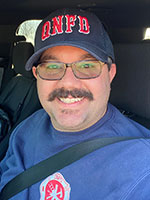
"I decided it was time to bring the idea up again," he said. "At the same time I was talking to one of the members of our governing body about starting some type of community paramedicine, another member saw a news report about it. I had information ready from our earlier plans, so when he asked me to give a presentation to the business committee, it didn't take much time to pull the needed info together. Right after that presentation, they said, 'Hey, we like this idea. Let's see what we can do.'"
Arnall noted a few more things serendipitously lined up to launch the program, including grant funding through the Federal Office of Rural Health Policy's Rural Tribal COVID-19 Response Program.
"Everything we wanted to accomplish with our program lined up with this funding opportunity," he said.
The grant's purpose is to provide maximum flexibility to assist rural and urban tribal organizations and health service providers to prevent, prepare for, and respond to the coronavirus and the evolving needs in rural communities.
Arnall said, in particular, Quapaw Nation's program goals aligned with the grant's support:
- provide at-home response, assessment, and treatment
- provide preventive care to the general and at-risk populations during the COVID-19 pandemic, especially the tribe's elders
- work with other local organizations, such as the local health department
- safely use telemedicine to prevent clinic or emergency room visits
- provide education and health guidance
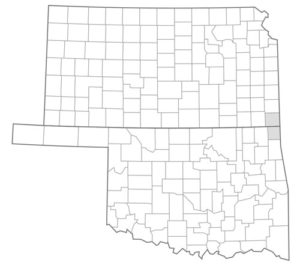
The grant project serves the nearly 35,000 people residing in Ottawa County, Oklahoma and the Quapaw Nation, located within about a 320-square-mile area mostly in Ottawa County but extending into Cherokee County, Kansas. According to Census Bureau information based on Oklahoma Tribal Statistical Area (OTSA) data, about 20% of the tribe's 5,300 residents are 65 or older. The tribe does not have a dedicated clinic or hospital and depends on local healthcare delivery systems.
Getting Started: Referrals ➔ Generate More Referrals ➔ Generates Community Collaboration
Arnall shared that he dealt with some personal apprehension at the program's start.
"One of our biggest worries was 'How do we start?'" he said. "I thought to myself, now that I can finally get out there and do this, where do we put our first boot on the ground?"
Arnall said the answer to that question came quickly and without controversy. They would start with the tribe's most susceptible population: its elders.
"We keep close track of our tribal elders," he said. "Number one for our work was to reach them at home. We knew they were our most susceptible to COVID and we didn't want them getting exposed in the emergency rooms or the clinics if we could take care of them in the home setting."
Despite his intuition around knowing what needed to be done, knowing how to get it done, and knowing that it would work, Arnall said he was surprised at initial responses to his outreach.
"They would say, 'No, I don't need you,'" Arnall said. "I gotta tell you, that stung a little bit. Yet, pretty soon, positive word-of-mouth from the people who did let me help them got around the community. I'd hear 'I've got a friend or a cousin who could use your help.' I also got referrals from my EMT colleagues that I'd been working with on our local ambulance for 15 years. They also understood how this program could benefit a lot of people."
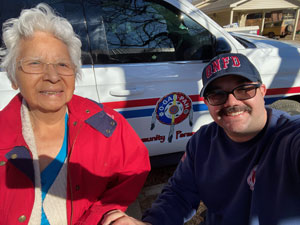
Arnall said he was not surprised referrals came from EMT colleagues. Part of ambulance EMT work is seeing firsthand how people's circumstances — often described by experts as the social determinants of health — directly and indirectly influence someone's health and well-being. Part of his desire to get this community paramedicine program going was its potential to nudge a needed change that could decrease non-emergency 911 calls.
"A local emergency system becomes well-known for its service," he said. "You can dial three numbers and somebody is at your front door in 10 minutes to take care of you. It's quick, it's easy, and it brings a sense of being safe. But so often, those calls are not really an emergency."
A Day in the Life of a Community Paramedic
According to a Centers for Disease Control and Prevention (CDC) brief, community paramedicine is a healthcare delivery model "intended to reduce 911 calls, emergency room crowding, and hospital readmissions. In demonstration projects, community paramedics often provide care in the home setting for individuals with chronic disease and limited health care access."
The brief indicated that the scope of practice varies according to state, but common skills include vital sign and glucose assessments as well as providing breathing treatments. In some states, medication interaction assessments are included. Tribal organizations are not subject to state requirements, but Arnall said he focuses on the traditional scope of practice. Kansas and Oklahoma have some guidance available.
Now that we've got the program going, our elders and others understand what I do. I tell them, 'I'm the guy that comes by to check on you.'
"Now that we've got the program going, our elders and others understand what I do," Arnall shared. "I tell them, 'I'm the guy that comes by to check on you. I'll take your blood pressure, your blood sugar, check your heart and lungs, and review your medications with you.' I'm hoping to get them healthier and keep them that way."
In these early months of their grant-supported work, Arnall said being able to see patients on a regular basis allowed him to not just identify and help with medical needs, but also see firsthand and help solve the non-medical needs that impact their health.
"There's a lot of times where people don't know where the resources are out there," he said. "When you don't have utilities or a place to stay, you don't even know where to turn. This impacts people's health for sure. There's a couple of things here. First, I can't believe how much I've learned myself about all of the community resources that are around us that can help. Second, I see up close the examples where solving these problems truly impacts people's physical and mental health."
Arnall talked more about this growing awareness of community services inventory and shared examples.
…because we've been the ones here to help them, it's really incredible to see up close how solving those problems really does improve things directly related to their health.
"Sometimes I work with adult protective services," he said. "Other times, I work with other community resources. For example, we've got a couple of local shelters operated by several of the local churches. It's been really great to be able to just call one person and say, 'Hey, this is what I'm looking for…' and they point me in the right direction. Sometimes I'll call someone else who says, 'Hey, I know just the person. Let me call them and I'll have them call you.' We've been able to help people with utilities. We've helped people get some ramps built. The list goes on and on. And because we've been the ones here to help them, it's really incredible to see up close how solving those problems really does improve things directly related to their health."
Arnall emphasized that when non-medical needs are addressed, improvement to someone's physical and mental well-being follows. He said sometimes these improvements are hard to measure, but he noted that having fewer non-emergent 911 calls is a start. He said he's also gratified when close follow-up with patients brings enough improvement that even his services are required less often.
Arnall pointed out that grant funds have provided vital equipment for the program work, such as a vehicle, a cardiac monitor, and equipment for monitoring blood pressure and blood sugar. There is also the needed software and hardware equipment for quick telehealth access to another medical provider when Arnall identifies the need for assistance. Arnall said he taps his tablet and connects with a local nurse practitioner who also carries a tablet and sees a patient in the "waiting room." Though the need for that additional help has been infrequent, he said even one request every couple of months to just visit with a patient or to prescribe antibiotics is another transport and clinic visit that's been avoided.
More on Community Paramedicine
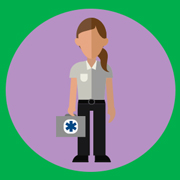 Many of Quapaw
Nation's grant-funded activities are exemplary of
evidence-based practices and benefits of community
paramedicine, also known as a model of "mobile
integrated healthcare." For other rural communities
interested in building a similar program, this RHIhub toolkit
— along with the RHIhub community
paramedicine topic guide — can provide
evidence-based information for consideration and
start-up. The National Rural Health Resource Center
also offers a
2021 resource focused on implementation and
sustainability.
Many of Quapaw
Nation's grant-funded activities are exemplary of
evidence-based practices and benefits of community
paramedicine, also known as a model of "mobile
integrated healthcare." For other rural communities
interested in building a similar program, this RHIhub toolkit
— along with the RHIhub community
paramedicine topic guide — can provide
evidence-based information for consideration and
start-up. The National Rural Health Resource Center
also offers a
2021 resource focused on implementation and
sustainability.
Making a Difference
Arnall said that the program's prime focus was offering an alternative to emergency room or clinic visits, especially for the older community members. Most of the people he sees are older than 65. He said he can't ignore how much a sense of isolation impacts mental health for this population — and, in turn, how much his home visits have made a difference.
"Our main focus was keeping care at home and that was important," he said. "But staying at home creates some isolation and mental health issues. Mental health has been overlooked for too long a time. It's hard to quantify how the value of a community paramedic can help for these issues. I've realized that sometimes it's just knowing someone is coming that provides them that sense of, well, a safety net."
Arnall thinks another important element of his visits is related to time, in contrast to a 20-minute limit for the usual clinic visit — or even "after-hours" calls.
I don't get those very often, but every now and again we'll have somebody who needs something late at night. Again, it just helps people knowing that somebody is around and it doesn't have to be the ambulance.
"I'm pretty flexible with time," he said. "If a patient needs me to sit and talk for an hour, we'll sit and talk for an hour. I've learned that time spent like that creates a bit of a safety net and allows me to really understand what's happening. Another example is the two o'clock in the morning calls with the 'Hey, I need this' or 'I need something' or 'Can you help me?' And I'll say, 'Let's get you taken care of.' I don't get those very often, but every now and again we'll have somebody who needs something late at night. Again, it just helps people knowing that somebody is around and it doesn't have to be the ambulance."
Arnall shared examples of how frequent 911 users have benefited from the program. Using what he referred to as "baby steps," he can see these people frequently and, little by little, get medical problems stabilized and social issues impacting health addressed, like setting up Meals on Wheels or some additional services by adult protective services. Again, outside of documenting that the 911 calls have decreased, he said it's hard to quantify how much some of those folks have been helped.
The Data Side of Program
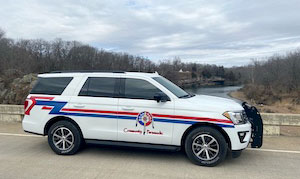 Arnall said that grant support has allowed free and
unrestricted referrals into the program. Ambulance crew
members, family members, friends, concerned community
members — and patients themselves —
can all request services. Despite the fact that there's
no revenue being generated as part of the grant-funded
program — as the team sorts out the
complexities that go with billing for community
paramedicine services — Arnall said they're
seeing a potential cost savings from decreased ambulance
utilization. An early figure still needing formal
validation is that they believe ambulance utilization
seems to be down by 17% since the start of the program.
He outlined why this can impact cost.
Arnall said that grant support has allowed free and
unrestricted referrals into the program. Ambulance crew
members, family members, friends, concerned community
members — and patients themselves —
can all request services. Despite the fact that there's
no revenue being generated as part of the grant-funded
program — as the team sorts out the
complexities that go with billing for community
paramedicine services — Arnall said they're
seeing a potential cost savings from decreased ambulance
utilization. An early figure still needing formal
validation is that they believe ambulance utilization
seems to be down by 17% since the start of the program.
He outlined why this can impact cost.
"About two to three years ago, we calculated that the average cost of an ambulance ride to the hospital with the advanced life support provided by a paramedic in the back with IVs, medications, and interventions like that to be a ballpark figure of around $3,000," he said. "Of course, you also have to tack on up to a $4,000 or more emergency room bill to that run. In the end, not all of these calls are actually emergencies. If the program can decrease the high utilization of even a few community members, that's a big difference. For example, there was a patient who was transported by EMS about 24 times in one year. To get someone with those needs into our program and making less 911 calls can be huge."
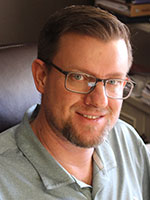
Brian Ross, Quapaw Nation's grant manager, is also vested in understanding the business impact of the current grant.
"A problem we have in rural healthcare is that there is a general lack of information to help us determine where the needs are and where focus should be," Ross said. "We'd certainly like to take any data we can gather linked to Kyle's work and analyze it to make some correlations. It'd also be important to have this data not only for our internal planning, but in order to connect with the hospitals and local service providers so we can better work together."
The Future
Arnall said that the current success of the program has allowed him the opportunity to dream about what a sustainable program could provide for his community. To start, he said workforce expansion is on his mind because he believes that there's enough work for a second community paramedic, which would expand the program's ability to see more people. As Ross mentioned, Arnall said he also recognizes there'd be benefits from increased engagement with the local hospitals, clinics, and medical providers.
According to Arnall, an expanded program would also allow an increase in the community education arm of the program's services.
"I would love to be doing more education than I'm doing now — for public gatherings, for community organizations, and more work with schools," he said. "Because there's so much we could do just along the lines of education, right now I have to be careful and rein myself back a little."
Ross said he, too, is looking to the future.
It's not so farfetched to say that we're bringing back the old-school country doctor visits that were so appreciated, but few people today have ever experienced.
"This grant helps support one of our short-term goals: assessing current needs to guide the long-term planning that's critical to meet local healthcare needs," Ross said. "For example, we don't want to assume that a fixed facility is the only way to go. This grant offers an opportunity to examine program costs and compare them to the costs of having a central building where more traditional care is administered.
"Kyle's work demonstrates that there is a strong demand for this community paramedicine service, not only to avoid the doctors' offices for non-emergency care during COVID, but is promising even for routine care. We've learned that people are going to call and have Kyle come to their homes. It's reassuring to know that people are willing to have a provider come to their door. It's not so farfetched to say that we're bringing back the old-school country doctor visits that were so appreciated, but few people today have ever experienced."

